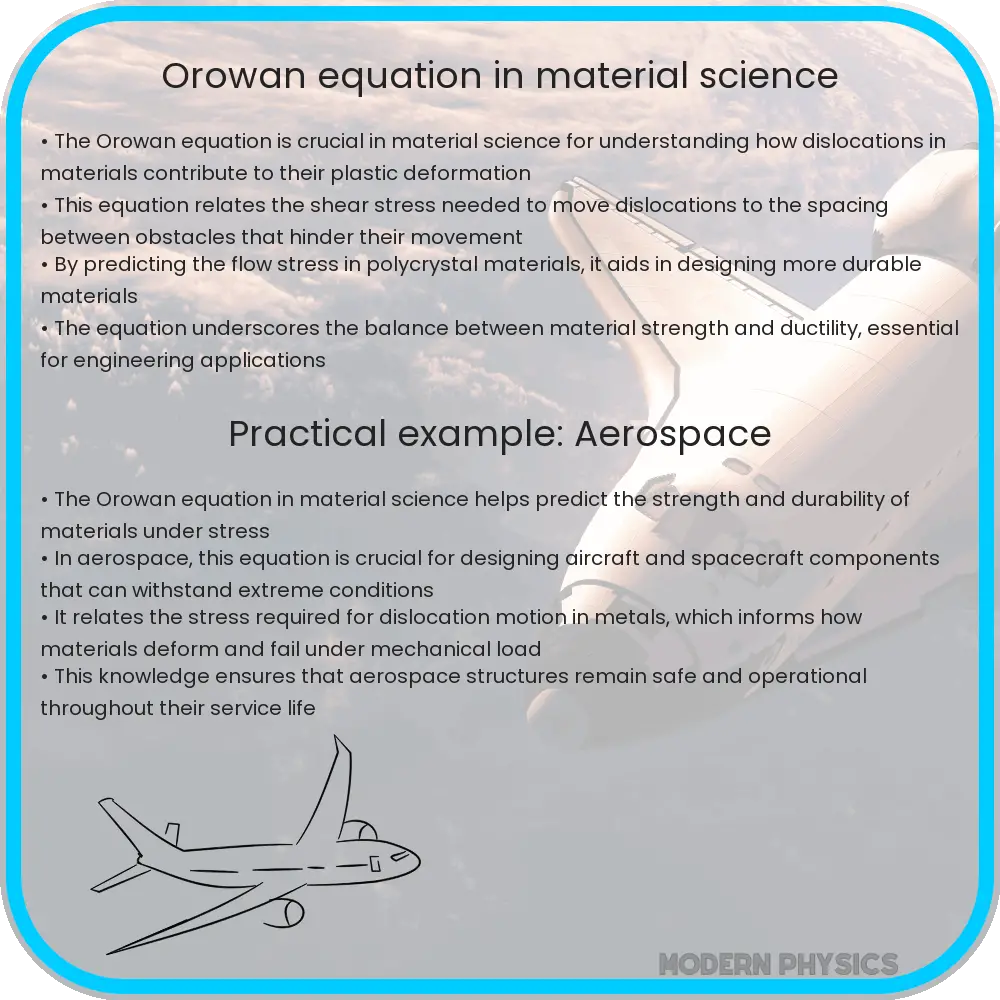Explore the Orowan Equation’s role in enhancing material strength through stress analysis and particle dispersion in our comprehensive guide.

Understanding the Orowan Equation: A Key Tool in Stress Analysis and Particle Dispersion
The Orowan Equation is a fundamental concept in materials science, particularly in the fields of stress analysis, particle dispersion, and strain theory. Developed by Egon Orowan, this equation provides a critical framework for understanding how dispersed particles within a material affect its overall strength and ductility. In this article, we delve into the intricacies of the Orowan Equation and its applications in modern engineering and materials science.
Principles of the Orowan Equation
At its core, the Orowan Equation relates to the strengthening mechanism in materials containing dispersed particles. It is particularly relevant for materials where particles are harder and more resistant to deformation than the surrounding matrix. This equation is expressed as:
Δσ = (M * G * b) / (L + 2r)
Where:
- Δσ represents the increase in yield strength due to particle dispersion.
- M is the Taylor factor, related to the material’s crystal structure.
- G denotes the shear modulus of the matrix material.
- b is the magnitude of the Burgers vector.
- L stands for the inter-particle spacing.
- r is the radius of the dispersed particles.
Applications in Stress Analysis
The Orowan Equation plays a vital role in stress analysis, particularly in assessing the strengthening effects of particle dispersion in metals and alloys. By understanding how particles impede dislocation movement, engineers can predict the material’s behavior under stress. This prediction is crucial for designing components that require high strength and durability, such as in aerospace and automotive industries.
Particle Dispersion and Strain Theory
In the context of strain theory, the Orowan Equation helps in understanding how dispersed particles influence the strain hardening behavior of a material. Strain hardening, or work hardening, is a phenomenon where a material becomes stronger and harder as it is plastically deformed. The presence of dispersed particles affects this process by providing obstacles to dislocation movement, thereby enhancing the material’s hardness and resistance to deformation.
Moreover, the equation assists in optimizing particle dispersion to achieve desired material properties. By altering variables like particle size (r) and inter-particle spacing (L), engineers can tailor materials to specific applications, balancing strength and ductility according to the requirements of the end product.
Enhancing Material Properties through Particle Dispersion
One of the significant advantages of applying the Orowan Equation in material science is the ability to enhance material properties through controlled particle dispersion. By adjusting the size, distribution, and type of particles within a matrix, engineers can create materials with superior mechanical properties. This customization is essential in industries where materials are exposed to extreme conditions, such as high temperatures or corrosive environments.
Challenges and Limitations
While the Orowan Equation provides a robust theoretical framework, it also has limitations. The accuracy of the equation can be affected by factors such as particle agglomeration, irregular particle shapes, and inhomogeneous distribution. Additionally, the equation primarily applies to elastic deformation and may not fully account for plastic deformation behaviors in some materials. Ongoing research and advanced computational methods are addressing these challenges, aiming to refine the equation’s applicability and accuracy.
Future Directions in Material Science
The Orowan Equation continues to be a subject of research and development in material science. Future advancements may include integrating the equation with other theoretical models to better understand complex material behaviors. Additionally, the rise of nanotechnology offers new frontiers for applying the Orowan Equation, especially in developing nano-reinforced composites with exceptional strength and flexibility.
Conclusion
The Orowan Equation remains a cornerstone in the field of material science, providing essential insights into the relationship between particle dispersion and material strength. Its application in stress analysis, particle dispersion, and strain theory has significantly contributed to the development of advanced materials in various industries. Despite its limitations, the ongoing evolution of this equation and its integration with modern technologies continue to enhance our understanding and ability to manipulate material properties. As we push the boundaries of material science, the principles of the Orowan Equation will undoubtedly play a crucial role in the discovery and application of innovative materials tailored for the challenges of the future.
